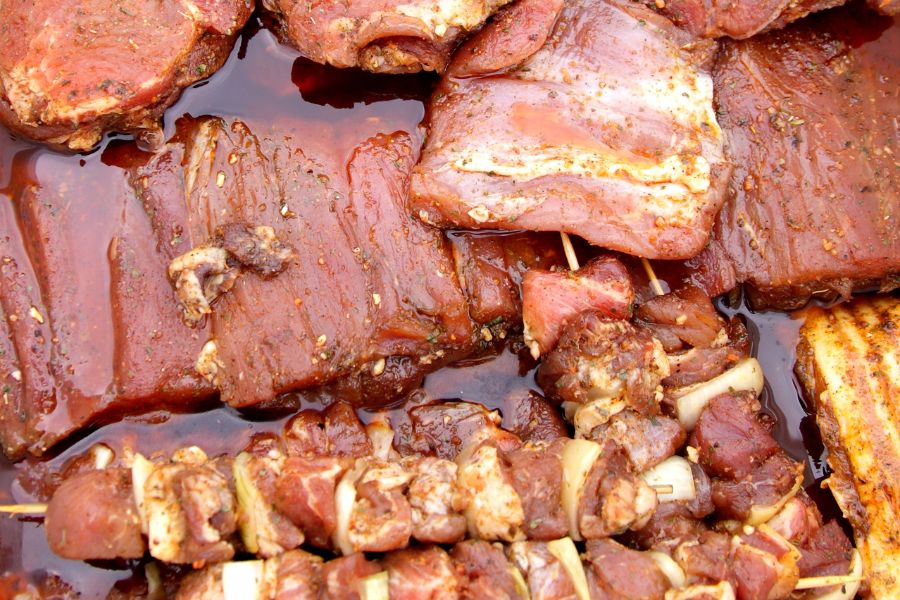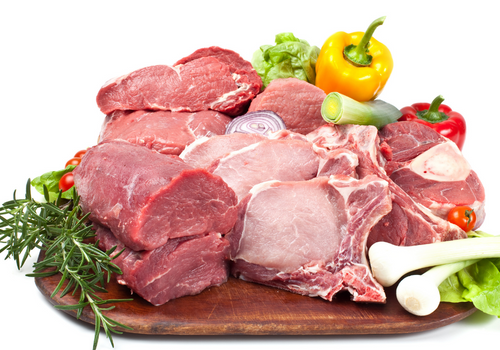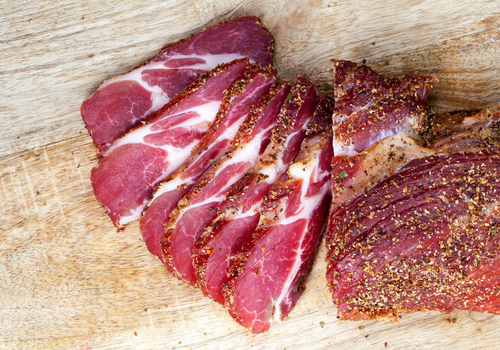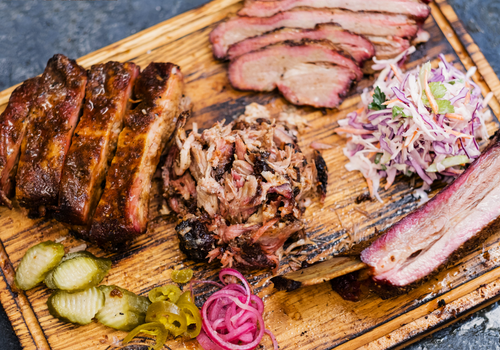First up, I must warn you that there is unlikely to be a clear-cut winner in this pork vs. beef comparison. Even if it comes from the same animal, meat is not just meat. Which cut ends up on the plate, how it was prepared, and who eats it are just a few variables in this equation with a lot of unknowns.
We can at least weigh the benefits and downsides of each type of meat. Vegetarians will probably be laughing at us right now as we try to find the lesser of two meat cuts with health controversies. However, using my culinary experience and what nutritional and environmental researchers have discovered, I’ll help you find out which cut of the animals are healthiest for you and our environment.

Most people will tell you that beef is healthier than pork. You might say this is logical since we generally see pork as a cut of meat with high fat content.
However, this generalization can only end up with some inaccuracies!
Saturated fats and cholesterol are the keywords when talking about the health side of meat.
So think about it, comparing a piece of lean beef like the sirloin steak with lean pork cuts like pork tenderloin would make pork the winner.
Sirloin tip side steak, the leanest beef cut, has a total fat content of 6.4 grams per 100 grams serving. Out of this, 2.6 grams are saturated fats.
Also, the pork tenderloin, which is the leanest pig cut, has 3.5 grams of total fats and 1.2 grams of saturated fat.
The above does not mean that consuming beef is unhealthy or that eating pork is healthier. However, you have to take into account the cut used.
If we compare pork cuts and beef that are fattier, beef is the better choice as pork contains a higher amount of unhealthy fats.
For instance, fattier cuts like pork belly has 53 grams of fats and has more saturated fat (20 grams). However, ribeyes, the fattiest beef steaks, have 37.6 grams of fats, 15 grams of which are saturated.

So let’s sort it out and start with the possible and common entry-level definition of meat: red or white. This is where the dilemma begins because there is no binding definition.
If I say the cut from an animal is red meat, what I mean is that the meat appears reddish when uncooked. Both pork and beef belong to this category. So, comparing pork and beef is not relatively easy, knowing that they belong to the same meat category.
Apparently, they contrast sharply with white meat such as fish, chicken, and turkey, which is paler in color and has more unsaturated fats.
A protein in muscle meat called myoglobin gives the meat this distinctive reddish color. The higher the myoglobin content, the redder the uncooked meat appears.
Poultry meat is relatively low in myoglobin, making it appear significantly paler than beef or pork, which is high in it.
Incidentally, a certain component of myoglobin is responsible for the color: heme iron. However, does that bring us closer to an answer?
In scientific studies, red meat usually comes off worse than white. Since 2015, the World Health Organization (WHO) has warned about how much we consume red meat products especially processed meat.
The organization classifies it as a potential carcinogen. Beef is – without a doubt – red meat.
There is much debate about whether pork should be classified within the types of white meats. This is because some culinary traditions classify pork as white meat.
However, due to its myoglobin level, it has a red coloration before being cooked. Both pork and beef are considered by the NHS to be red meat.
Usually, pork does not have a good image as a superfood due to its relationship with saturated fat. But wait, not everything is bad. As I mentioned, it all depends on the cut of pig.
So I won’t compare a sausage with a hamburger, but the leaner and more substantial parts of these animal proteins.
If we choose pork loin as our favorite protein, we must highlight its vitamin content, such as B1, B2, B6, and B12. Similarly, lean beef meat provides mainly vitamins B1, B2, B6, and B12.
Among the nutritional value of beef, it also has vitamin A in the form of retinol; essential for bone development and maintenance of epithelial cells.
In terms of minerals, pork loin is high in calcium and phosphorus. Meanwhile, beef is rich in zinc and iron. This is why it is a suitable protein for people with anemia.
Lean pork tenderloin can provide about 20.99 grams of protein per 100 grams consumed. Meanwhile, lean beef provides 20.7 grams per 100 grams of edible portion. So the comparison is fairly equal between the two sources of protein.
Note that both types of meat are excellent protein sources of high biological value.
On the other hand, speaking of the calories of beef tenderloin vs. a beef fillet and its calories, the former has about 288 calories per 100 grams, while a fillet has 135.
Other parts of the pig have a higher number of calories. For example, the pig’s feet provide 291 calories, where approximately every 100 grams are fat.
Both beef and pork have high amounts of fatty acids of animal origin, even lean cuts that usually have a lower percentage. So their consumption should be prudent.
In estimation, pork contains 70 mg of cholesterol per 100 grams, while beef has about 59-65 mg per 100 grams.

The environmental impact of beef production, such as greenhouse gas emissions, is widely documented. Livestock is responsible for the emission of up to 14.5% of these gases globally, especially methane.
On the other hand, pig production also affects the environment. Its direct impact is related to the waste produced by pigs. Nitrous oxide comes from pig hog waste, which has 300 times an earth-warming potential than CO2.
Also, high-proportion pig production systems can release excessive amounts of nitrogen and phosphorus that can affect the soil and the evolution of the biological cycle.
If you’re looking for meat safer in consumption, beef is the one for you. For safe consumption, pork MUST be thoroughly cooked. But still, you should never eat raw or undercooked beef.
One of the main infections from consuming undercooked or raw pork is trichinosis, a larva of an intestinal worm that can be fatal.
Although in the western world, it is an infection that has few cases due to the exhaustive controls and sanitary measures passed by meat from farms.
On the other hand, one is more likely to have tapeworm from the consumption. People are infected every year by eating raw or undercooked meat.
Despite ever-improving hygiene, parasites can still be found in meat. Although the dreaded roundworm parasites, the so-called trichinae, which usually nest in raw pork, have been strictly controlled for many decades.
So the risk of catching something with a Mett is very low. However, Sarcosporidia or tapeworm larvae can be found in beef and pork.
Pregnant women, in particular, should generally avoid raw and undercooked meat products. From salami to minced meat – infection with the parasite Toxoplasma gondii is particularly dangerous during pregnancy. It can cause considerable damage to the unborn child.
So, there is one important word to remember about the preparation: the motto is always cook the meat or fry it well – regardless of whether it’s beef or pork.
That’s why I always advise you to cook the pork well. Whether beef or pork, ensure your dish has an internal cooking temperature of at least 145 degrees Fahrenheit which is the USDA recommendation.
This means you’d need to have a kitchen thermometer that allows you to verify the correct temperature.
From a hygienic point of view, raw or undercooked meat should always be consumed with caution.

Beef fed with grass comprises of healthy fats and higher protein sources. It has about 40-50% of saturated fat composition.
However, it also has about 40% of monounsaturated fat and about 10% of polyunsaturated fat. Beef fed with grass has as less saturated fat as a cut of skinless chicken.
Related Reading
Pork is often lower in calories than all other red meats. So, it’s a good option for people looking to lose weight. For example, a 100-gram cut of whole pork loin has about 242 calories.
Meanwhile, brisket beef calories amount to about 255 calories. Lean ground beef also has something similar, about 250 calories. But lean ground pork has about 164 calories.
Related Reading
It is impossible to say in general terms which meat is better for your health. Rather, I recommend keeping meat consumption moderate in general. If you like pork, choose leaner cuts. If beef is your thing, prefer grass-fed beef and stay away from processed products.
Beef turned out to be relatively healthier, unlike pork, in which so many parasites are often found. Like I mentioned in this pork vs beef comparison, you’d be fine if you cook your recipes well, ensuring they reach the 145 degrees Fahrenheit internal cooking temperature after cooking.
Finally, I know we’re always tempted to choose meat cuts with some fat content because of the flavor and tenderness they bring. But leaner cuts of beef and pork are considered healthy meats.